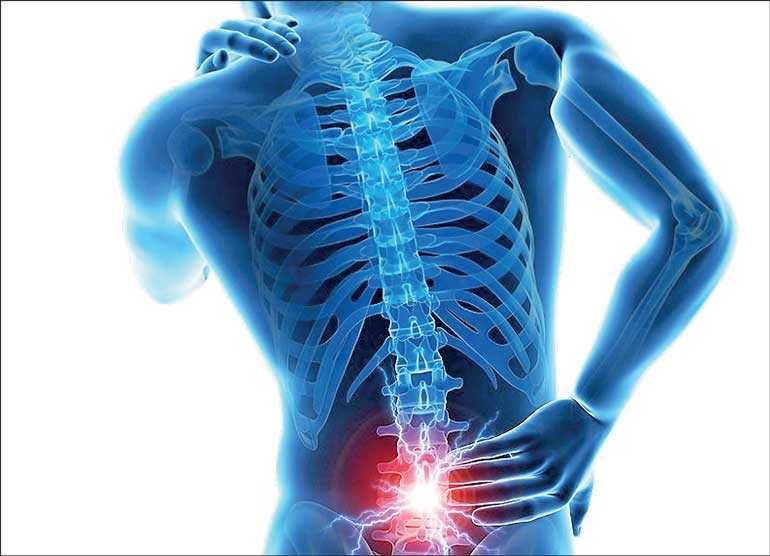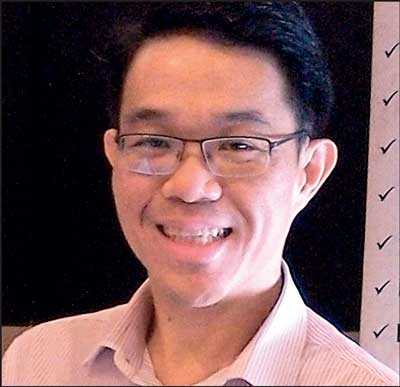Saturday Dec 13, 2025
Saturday Dec 13, 2025
Wednesday, 28 November 2018 00:00 - - {{hitsCtrl.values.hits}}

By Fathima Riznaz Hafi
The backbone or spine is an important structure for many functions – it supports our body’s weight, protects the spinal cord, controls the posture and is also the attachment point for muscles. Maintaining a healthy spine enables it to function smoothly.
 |
Mount Elizabeth Hospital Singapore Orthopaedic Surgeon Dr. Tow Phak Boon Benjamin |
During a visit to Colombo recently, Mount Elizabeth Hospital Singapore Orthopaedic Surgeon Dr. Tow Phak Boon Benjamin spoke to Daily FT about protecting the spine, sharing useful guidelines on how to keep it strong and healthy. “In order to understand how to have a healthy spine, we have to understand the structure of the spine,” he said. Understanding its structure would help us understand the extent to which our habits can have either beneficial or detrimental effects on our spine.
The spine is made up of intervertebral discs (consisting of fibrous tissue on the outside and jelly on the inside), which act as cushions that absorb shock. The muscles and nerves around it support the spine. Strong muscles and bones, flexible tendons and ligaments, and nerves contribute to a healthy spine. We have to protect this structure from strain, injury, or disease to ensure it remains healthy. It is when we neglect this structure that we start experiencing pains in various parts of the back or neck, which indicate that the structure is deteriorating, he explained.
“The most common form of failure in the spine, is failure of the cushion – the intervertebral disc fails – and when the fibrous tissues tear the person gets chronic pain. A lot of people who have back problems, present themselves with back pain on prolonged activities – if they sit for a long time, change position, get out of a chair, turn their body, get out of bed, get out of a vehicle, cough or sneeze, they get back pain.
“These are all signs of damage to the spine and occur because the disc/cushion is not able to take the body’s weight so well; there are tears in the outer lining or the jelly is pushing out; and if the tears, the jellies start to push out more, they can compress on to the nerves resulting in nerve pain, buttock pain, thigh pain and leg pain – that is ‘nerve compression’.
“If it presses on your left leg nerve you get left leg pain, if it presses on the right leg nerve you get right leg pain, if it presses on the neck nerve it causes arm pain, shoulder pain, shoulder blade pain. Pain in the neck, shoulder blade and arm is due to a slipped disc in the neck. Pain in the back, buttock and leg is due to a slipped disc in the back – lower back and spine,” he added.
Such conditions can easily be prevented by following a few guidelines to protect the back and keep it strong.
Guidelines for a healthy back
“A healthy back starts with good posture!” stressed Dr. Tow. He advised practising good posture when standing, walking, sitting, and carrying out any physical activity, so that the least amount of strain is placed on the spine.
Dr. Tow cautioned not to sit in a fixed position for a prolonged period, pointing out that people who work at the office tend to sit in the same position for many hours. “White collar workers spend hours sitting at their desk and in doing their work, their mind is the most important part – so their mind is so engrossed in the work, they forget about their neck and back. Similarly, when using our mobile phones, tablets and laptops, we are always looking downwards and hunching forward. That puts a lot of stress on the back and neck. Then over the years, there is accumulation of many problems.
“Manual workers don’t have a these issues because they are active – always moving and not putting their bodies in the same position all the time. Since they are constantly in motion, their blood circulation is good and their overloading is never for too long.”
“You should sit at your desk for no more than 30 or 45 minutes; then you should get up, stand straight and stretch backwards because that takes a bit of the load off the cushions of the spine (intervertebral discs). If you spend a lot of time bending forward you have a lot of back problems because the cushion is overloaded. Same applies for the neck. After half an hour you should stretch your neck upwards, look to the left, and the right, thereby taking pressure off the spine. These are the basics you need to do,” he suggested.
“You must have good lifting habits as well. Avoid overloading of your back, avoid hunching your body forward when you lift heavy objects because when you bend all the way downward, that weight is borne by the back, so when you bend like that you feel more back pain. Therefore, when you’re lifting something you should keep your back straight, bend your hips and knees and go down slowly,” he added.
Asked what should be done if that patient has knee pain issues and can’t bend that way, Dr. Tow said: “Then you should use the furniture around you – use external devices to help you lift objects slowly, because if you have knee pain, you cannot do lifting and squatting – you may have to hold on to something – use a chair as a support, bend down and lift. When bending down to lift with a support, half the body weight is shared by the furniture – it helps to prevent overloading of the back.”
Back pain and sports
Dr. Tow advised caution in choosing sports and exercises as well. People with back pain should choose sports and exercises that suit their condition, he says. Certain sports involve a lot of loading, bending and twisting – these actions put a lot of strain on the intervertebral discs. Weight-lifting, golf, tennis, squash, bowling, etc. can increase the risk of injury to the spine. This does not mean you should stop pursuing these sports, but before commencing you should do some warm-ups; do a little bit of stretching, make the ligaments and muscles in the correct tension; and when you do it, especially if you are not very fit, don’t do it to a very extreme level because high speed rotation and twisting and loading will cause the tissues to suddenly tear. Gradual loading allows the soft tissues to stretch out and the injury to the backbone, cushion and cartilage is less severe. There should be no sudden movement and no sudden jerking, he advises.
Dr. Tow recommends swimming as more suitable for people with back pain, or the elliptical trainer if they want to do cardiac workouts. He says it is better to avoid sit-ups and lifting kettlebells or bench presses, as those put a lot of strain on the back, but adds that it’s okay if you bench press while lying flat. It’s also okay to do a pull down or chin up because it doesn’t put much stress on the back.
Is osteoarthritis similar to osteoporosis?
Back pains and joint pains can be difficult to bear but even more unbearable are conditions such as osteoarthritis. An ailment that affects a vast number of people, osteoarthritis can have severe debilitating effects on a person. As it is often confused with osteoporosis, another severely debilitating condition, Dr. Tow was asked if it is similar, to which he replied, “No, it is not – osteoarthritis is a problem of cartilage wear and tear in the joints. Cartilage is rubbing and is worn out and there is pain and inflammation in the weight-bearing joints, or the overloaded or overused joints; like in the knee and hip. Osteoporosis on the other hand, is a problem with mineralisation of the bone; there are not enough minerals in the bone and when there are not enough minerals the bones become weak.”
“Osteoarthritis patients have pains in the joints – knee pain, hip pain, back pain, shoulder pain, etc. but osteoporosis is silent – it has no symptoms until you break your bones, then it is very painful,” he added.
Preventing progression of osteoarthritis
Osteoarthritis is caused by age, over-loading, and wear and tear. Once diagnosed and once the symptoms start to show, are there exercises, diet or anything that we can do to prevent progression of osteoarthritis? Dr. Tow said there are, and explained, “If you have osteoarthritis of the knee, which means your cartilage is already worn out until it is very bad, you cannot turn back the clock; but if you want to slow that down, you should load that part less and use it less.”
White collar workers spend hours sitting at their desk and in doing their work, their mind is the most important part – so their mind is so engrossed in the work, they forget about their neck and back. Similarly, when using our mobile phones, tablets and laptops, we are always looking downwards and hunching forward. That puts a lot of stress on the back and neck. Then over the years, there is accumulation of many problems.
You should sit at your desk for no more than 30 or 45 minutes; then you should get up, stand straight and stretch backwards because that takes a bit of the load off the cushions of the spine (intervertebral discs). If you spend a lot of time bending forward you have a lot of back problems because the cushion is overloaded. Same applies for the neck.
“If you do activities and sports you should choose activities that load the joints less. You should not take up jogging, or marathon running as your primary exercise. You can change to cycling or swimming – activities that don’t load the joints so much. Maintaining your weight also helps. If you cut down on your weight, the demand on the joint is naturally cut down,” he said, adding that some people take glucosamine and chondroitin, which are supplements used in treatment for osteoarthritis, but there is no strong scientific basis for their use. At best, they can slow down the progression but they don’t turn back the clock – they don’t cure.
When all else fails
If symptoms are not too bad, patients are generally advised to do the appropriate exercises, and to control their weight. But for some patients the arthritis is really bad. “Elderly patients in their 60s and 70s suffer a lot of pain; in the morning when they wake up their joints are stiff, and they have difficulty walking and climbing stairs. These people are retirees – they want to enjoy their retirement, they want to be able to exercise and be fit, but when they have very bad arthritis they can’t exercise; they can’t function. In such cases, there are procedures to restore their function; there are injections to lubricate the joints, and surgery to replace worn-out surfaces of the joints so that we can restore their lifestyle after surgery.”
Asked if it is a complicated surgery, he said, “Knee joint and hip joint replacement is very simple – very straightforward and can give patients good quality of life, because it takes away their pain. After surgery their walking, standing and sitting abilities become much better. The quality of life improves by a lot.”
Dr. Benjamin Tow is a spine surgeon, specialised in treating degenerative conditions of the spine, deformity surgery and minimally invasive spine surgery, as well as percutaneous injections for spine conditions. Apart from spine surgery, Dr. Tow has extensive experience in managing general orthopaedic conditions of the knee, hip, ankle and upper limb. He can be contacted through Parkway Patient Assistance Centre on: 0112809000.